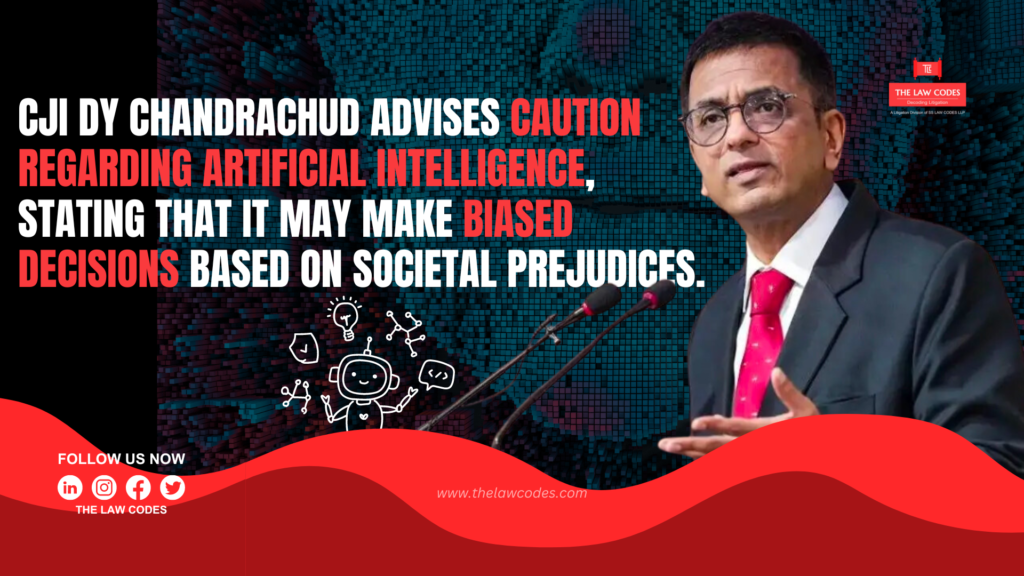The Chief Justice of India, D. Y. Chandrachud, recently discussed how no technology is neutral and how its deployment in the actual world can reflect human values. The CJI addressed the importance of considering the human and societal values that technology represents, particularly in the context of their deployment. This is because technology does not evolve in a social vacuum. “They occur within a complex web of societal realities and legal, economic, and political structures,” he explained.
CJI DY Chandrachud, speaking at the 60th Convocation Ceremony of Indian Institute of Technology (IT) Madras, described how Artificial Intelligence, despite its immense potential, can be used to perpetuate discrimination and unjust treatment:
“A significant impact of Al is its potential to amplify discrimination and undermine the right to fair treatment. Many Al systems have been shown to exhibit biased decision making based on data inputs that reflect societal prejudices. For example, Al recruitment tools deployed by firms favoured men over women because the tools were trained on profile of successful employees who, for gendered reasons, happened to be predominantly male. In this, data driven systems can perpetuate biases and marginalise the social control mechanisms that govern human behaviour.“
According to the Chief Justice, the actual redemption of technology rests in empowering every individual’s freedoms and human rights. He stated that technology can make us resist threats threatening future liberties.
He also expressed concern regarding the potential for Al to be abused for intimidation, threatening, and deception:
“Today Artificial Intelligence are the two words on everybody’s lips. Al is being deployed rapidly to enhance the efficiency of computer software and hardware. In a relatively short time, Al tools such as ChatGPT has shown that even computer can crack a joke, write codes or even draft legal memos. Even in the Supreme Court, we are using Al on a pilot basis for live transcriptions of court proceedings. The trepidations voiced by many about the advent of Al is an example of how new technologies do not exist in a vacuum. Always keep in mind what values Al represents and what affordances it creates. I have personally been fascinated with the Al image-generating software, which allows you to put in a written prompt and generate an image, but I am also cognisant of its potential misuse to create deep fakes, to mislead and to bully individuals.“
The Chief Justice discussed the capacity of science and technology to advance human rights and freedom. According to him, each incremental improvement in technology can potentially improve individuals’ lives, reconcile societal divides, and promote justice. However, according to the CJI, new technologies can facilitate unintended behaviour. In this context, he discussed the menace of technological surveillance:
“With the advent of emails you may never know that your email is being intercepted and this can now be done at an unprecedented scale. Thus, while electronic communication shows values of communication and collaboration they also create the possibility of mass surveillance of our most intimate details and ideas. Privacy, confidentiality, security, transparency and anonymity are some of the basic expectations people have from technology they use. Both technology and law have striven to secure this. We all want our messages to now be end-to-end encrypted and this shows how every new technology creates new affordances which in turn modify human behaviour and lead to new technology,” he stated.
Chief Justice Chandrachud also discussed the impact of technology on the judicial system. It has facilitated access to justice and can also assist in better informing citizens:
“During the Covid-19 pandemic, the Supreme Court introduced the virtual court system, which, to date, allows litigants and lawyers from outside Delhi to appear before the Supreme Court. Courts across India held as many as 43 million hearings. These millions of hearings made us realise how Virtual Courts helped female lawyers who otherwise faced difficulty appearing in court due to the gendered demands of domestic work and caregiving. With VCs, they could argue from their homes.
VC also facilitated the live-streaming of Constitution bench proceedings, which has helped citizens stay informed about ongoing cases. The values of video conference extend beyond mere communication and collaboration to encompass inclusivity and access to justice,” the CJI explained.
The CJI also addressed the interaction between law and technology in fostering progress:
“It is often said technology develops at a speed with which the law cannot keep up with. This may seem true in the heat of the moment, but if we take a step back, our history would be a testament to the fact that law and technological developments share a dialectic relationship. They speak to speak to one another constantly, each one pushing the other forward. At one point in time in history, ships were considered the pinnacle of modern technology but with every voyage came a risk of losing all your goods and human lives to the high seas. It was the law of corporate ownership and financing that allowed businesses to manage the risk of overseas voyages leading to first generation of entrepreneurs and venture capitalists. Later it was the rapid technological evolution of the industrial revolution that led to the development of labour law and patent law.“
